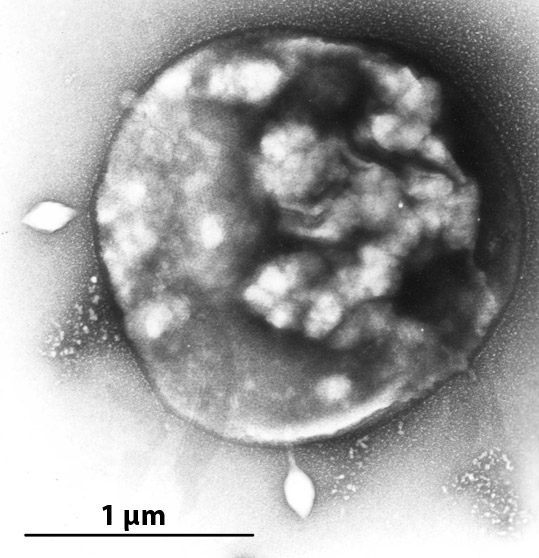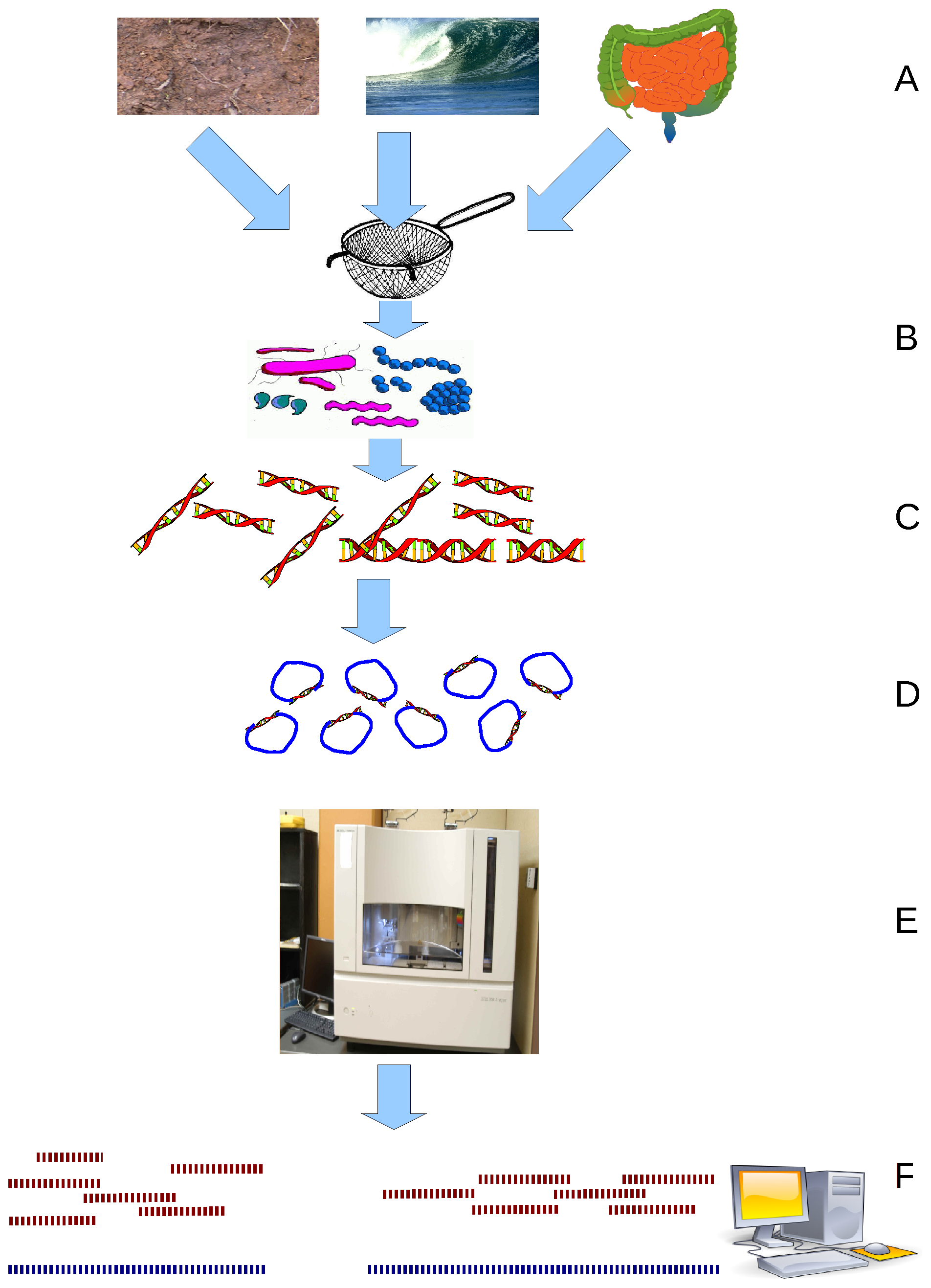|
Archaeal Viruses
An archaeal virus is a virus that infects and replicates in archaea, a domain of unicellular, prokaryotic organisms. Archaeal viruses, like their hosts, are found worldwide, including in extreme environments inhospitable to most life such as acidic hot springs, highly saline bodies of water, and at the bottom of the ocean. They have been also found in the human body. The first known archaeal virus was described in 1974 and since then, a large diversity of archaeal viruses have been discovered, many possessing unique characteristics not found in other viruses. Little is known about their biological processes, such as how they replicate, but they are believed to have many independent origins, some of which likely predate the last archaeal common ancestor (LACA). Much of the diversity observed in archaeal viruses is their morphology. Their complete bodies, called virions, come in many different forms, including being shaped like spindles or lemons, rods, bottles, droplets, and coil ... [...More Info...] [...Related Items...] OR: [Wikipedia] [Google] [Baidu] |
Adnaviria
''Adnaviria'' is a Realm (virology), realm of viruses that includes archaeal viruses that have a filamentous virion (i.e. body) and a linear, double-stranded DNA genome. The genome exists in A-form (A-DNA) and encodes a dimeric major capsid protein (MCP) that contains the SIRV2 fold, a type of alpha-helix bundle containing four helices. The virion consists of the genome encased in capsid proteins to form a helical nucleoprotein complex. For some adnaviruses, this helix is surrounded by a lipid membrane called an Viral envelope, envelope. Some contain an additional protein layer between the nucleoprotein helix and the envelope. Complete virions are long and thin and may be flexible or a stiff like a rod. ''Adnaviria'' was established in 2020 after cryogenic electron microscopy showed that the viruses in the realm were related due to a shared MCP, A-DNA, and general virion structure. Viruses in ''Adnaviria'' infect hyperthermophilic and acidophilic archaea, i.e. archaea that inhabit ... [...More Info...] [...Related Items...] OR: [Wikipedia] [Google] [Baidu] |
Thermoproteota
The Thermoproteota are prokaryotes that have been classified as a phylum (biology), phylum of the domain Archaea. Initially, the Thermoproteota were thought to be sulfur-dependent extremophiles but recent studies have identified characteristic Thermoproteota environmental rRNA indicating the organisms may be the most abundant archaea in the marine environment. Originally, they were separated from the other archaea based on rRNA sequences; other physiological features, such as lack of histones, have supported this division, although some crenarchaea were found to have histones. Until 2005 all cultured Thermoproteota had been thermophilic or hyperthermophilic organisms, some of which have the ability to grow at up to 113 °C. These organisms stain Gram negative and are morphologically diverse, having rod, cocci, Filamentation, filamentous and oddly-shaped cells. Recent evidence shows that some members of the Thermoproteota are methanogens. Thermoproteota were initially classif ... [...More Info...] [...Related Items...] OR: [Wikipedia] [Google] [Baidu] |
Prokaryote
A prokaryote (; less commonly spelled procaryote) is a unicellular organism, single-celled organism whose cell (biology), cell lacks a cell nucleus, nucleus and other membrane-bound organelles. The word ''prokaryote'' comes from the Ancient Greek (), meaning 'before', and (), meaning 'nut' or 'kernel'. In the earlier two-empire system arising from the work of Édouard Chatton, prokaryotes were classified within the empire Prokaryota. However, in the three-domain system, based upon molecular phylogenetics, prokaryotes are divided into two domain (biology), domains: Bacteria and Archaea. A third domain, Eukaryote, Eukaryota, consists of organisms with nuclei. Prokaryotes evolution, evolved before eukaryotes, and lack nuclei, mitochondria, and most of the other distinct organelles that characterize the eukaryotic cell. Some unicellular prokaryotes, such as cyanobacteria, form colony (biology), colonies held together by biofilms, and large colonies can create multilayered microbial ... [...More Info...] [...Related Items...] OR: [Wikipedia] [Google] [Baidu] |
Bacteriophage
A bacteriophage (), also known informally as a phage (), is a virus that infects and replicates within bacteria. The term is derived . Bacteriophages are composed of proteins that Capsid, encapsulate a DNA or RNA genome, and may have structures that are either simple or elaborate. Their genomes may encode as few as four genes (e.g. Bacteriophage MS2, MS2) and as many as hundreds of genes. Phages replicate within the bacterium following the injection of their genome into its cytoplasm. Bacteriophages are among the most common and diverse entities in the biosphere. Bacteriophages are ubiquitous viruses, found wherever bacteria exist. It is estimated there are more than 1031 bacteriophages on the planet, more than every other organism on Earth, including bacteria, combined. Viruses are the most abundant biological entity in the water column of the world's oceans, and the second largest component of biomass after prokaryotes, where up to 9x108 virus, virions per millilitre have b ... [...More Info...] [...Related Items...] OR: [Wikipedia] [Google] [Baidu] |
Synteny
In genetics, the term synteny refers to two related concepts: * In classical genetics, ''synteny'' describes the physical co-localization of genetic loci on the same chromosome within an individual or species. * In current biology, ''synteny'' more commonly refers to ''colinearity'', i.e. conservation of blocks of order within two sets of chromosomes that are being compared with each other. These blocks are referred to as ''syntenic blocks''. The Encyclopædia Britannica gives the following description of synteny, using the modern definition: Etymology ''Synteny'' is a neologism meaning "on the same ribbon"; Greek: ', ''syn'' "along with" + ', ''tainiā'' "band". This can be interpreted classically as "on the same chromosome", or in the modern sense of having the same order of genes on two (homologous) strings of DNA (or chromosomes). : co-localization on a chromosome The classical concept is related to genetic linkage: Linkage between two loci is established by the observat ... [...More Info...] [...Related Items...] OR: [Wikipedia] [Google] [Baidu] |
Cryogenic Electron Microscopy
Cryogenic electron microscopy (cryo-EM) is a transmission electron microscopy technique applied to samples cooled to cryogenic temperatures. For biological specimens, the structure is preserved by embedding in an environment of vitreous ice. An aqueous sample solution is applied to a grid-mesh and plunge-frozen in liquid ethane or a mixture of liquid ethane and propane. While development of the technique began in the 1970s, recent advances in detector technology and software algorithms have allowed for the determination of biomolecular structures at near-atomic resolution. This has attracted wide attention to the approach as an alternative to X-ray crystallography or NMR spectroscopy in the structural biology field. In 2017, the Nobel Prize in Chemistry was awarded to Jacques Dubochet, Joachim Frank, and Richard Henderson "for developing cryo-electron microscopy for the high-resolution structure determination of biomolecules in solution." '' Nature Methods'' also named cryo- ... [...More Info...] [...Related Items...] OR: [Wikipedia] [Google] [Baidu] |
Metagenomics
Metagenomics is the study of all genetics, genetic material from all organisms in a particular environment, providing insights into their composition, diversity, and functional potential. Metagenomics has allowed researchers to profile the microbial composition of Natural environment, environmental and clinical samples without the need for time-consuming Microbiological culture, culture of individual species. Metagenomics has transformed microbial ecology and evolutionary biology by uncovering previously hidden biodiversity and metabolic capabilities. As the cost of DNA sequencing continues to decline, metagenomic studies now routinely profile hundreds to thousands of samples, enabling large-scale exploration of microbial communities and their roles in health and global ecosystems. Metagenomic studies most commonly employ shotgun sequencing though Third-generation sequencing, long-read sequencing is being increasingly utilised as technologies advance. The field is also referre ... [...More Info...] [...Related Items...] OR: [Wikipedia] [Google] [Baidu] |
Wolfram Zillig
Wolfram may refer to: * Wolfram (name), a Germanic masculine given name and a surname (includes a list of people with the name) * Wolfram (musician), an Austrian DJ * Wolfram (element), the original name for the chemical element best known as tungsten * Wolfram Research, a software company known for the symbolic computation program Mathematica ** Wolfram Language, the programming language used by Mathematica ** Wolfram code, a naming system for one-dimensional cellular automaton rules introduced by Stephen Wolfram * Wolfram syndrome, a genetic disorder * Wolfram, Queensland Wolfram is a former mining town within the Suburbs and localities (Australia), locality of Dimbulah, Queensland, Dimbulah in the Shire of Mareeba in Queensland, Australia, now a ghost town. Geography Wolfram is about west of Cairns, Queens ..., a former mining town in Australia * The ''Wolfram'', a fictional military airship in the air combat video game '' The Sky Crawlers: Innocent Aces'' {{Disamb ... [...More Info...] [...Related Items...] OR: [Wikipedia] [Google] [Baidu] |
Salinity
Salinity () is the saltiness or amount of salt (chemistry), salt dissolved in a body of water, called saline water (see also soil salinity). It is usually measured in g/L or g/kg (grams of salt per liter/kilogram of water; the latter is dimensionless and equal to per mille, ‰). Salinity is an important factor in determining many aspects of the chemistry of natural waters and of biological processes within it, and is a state function, thermodynamic state variable that, along with temperature and pressure, governs physical characteristics like the density and heat capacity of the water. A contour line of constant salinity is called an ''isohaline'', or sometimes ''isohale''. Definitions Salinity in rivers, lakes, and the ocean is conceptually simple, but technically challenging to define and measure precisely. Conceptually the salinity is the quantity of dissolved salt content of the water. Salts are compounds like sodium chloride, magnesium sulfate, potassium nitrate, and sod ... [...More Info...] [...Related Items...] OR: [Wikipedia] [Google] [Baidu] |
Bicaudavirus
''Bicaudaviridae'' is a family of hyperthermophilic archaeal viruses. Members of the genus ''Acidianus'' serve as natural hosts. There is only one genus, ''Bicaudavirus'', and one species, Acidianus two-tailed virus (''Bicaudavirus pozzuoliense''), in this family. However, Sulfolobus tengchongensis spindle-shaped viruses 1 and 2 ( STSV1 and STSV2) are regarded to belong to this family also. Structure Viruses in ''Bicaudaviridae'' are non-enveloped, with lemon-shaped geometries. Genomes are circular dsDNA molecules of around 48–76 kb in length. High-resolution structure was determined by cryo-EM for Sulfolobus monocaudavirus 1 (SMV1) and a lower-resolution structure was determined for Acidianus two-tailed virus (ATV). Virions of both viruses have helical symmetry, with continuous 7-start helices, composed of the single major capsid protein, forming both the tails and the spindle-shaped body. The major capsid protein structure and virion organization of bicaudaviruses are simila ... [...More Info...] [...Related Items...] OR: [Wikipedia] [Google] [Baidu] |
Adaptation
In biology, adaptation has three related meanings. Firstly, it is the dynamic evolutionary process of natural selection that fits organisms to their environment, enhancing their evolutionary fitness. Secondly, it is a state reached by the population during that process. Thirdly, it is a phenotypic trait or adaptive trait, with a functional role in each individual organism, that is maintained and has evolved through natural selection. Historically, adaptation has been described from the time of the ancient Greek philosophers such as Empedocles and Aristotle. In 18th and 19th-century natural theology, adaptation was taken as evidence for the existence of a deity. Charles Darwin and Alfred Russel Wallace proposed instead that it was explained by natural selection. Adaptation is related to biological fitness, which governs the rate of evolution as measured by changes in allele frequencies. Often, two or more species co-adapt and co-evolve as they develop adaptations tha ... [...More Info...] [...Related Items...] OR: [Wikipedia] [Google] [Baidu] |








